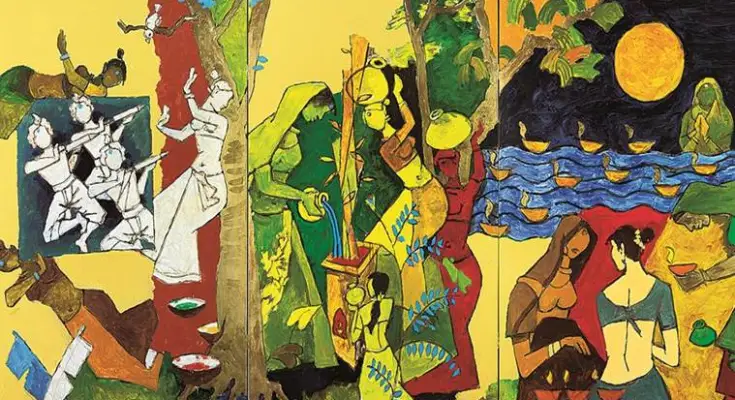
Exhibited at the Victoria and Albert Museum in London in 2014, the last works of MF Husain will now be showcased in the US for the first time.
 |
| M F Husain. Traditional Indian Festivals, 2008–2011. Photo © The Victoria and Albert Museum, London |
At 95, when he died in exile in London, MF Husain was still painting several hours a day. He dreamed of returning to India, his muse. When he breathed his last, the artist was immersed in Indian history and was researching its rich civilisation and painting it on his canvas. In the series, titled Indian Civilisation, commissioned by Usha Mittal, wife of steel tycoon Lakshmi Mittal, the artist was to create 32 giant triptychs to celebrate the nation.
Before his death, Husain had managed to paint only eight of the panels. Exhibited at the Victoria and Albert Museum in London in 2014, the works will now be showcased in the US for the first time. The exhibition, “India Modern: The Paintings of MF Husain”, will be held at the Art Institute of Chicago. “Interspersed among centuries of Indian sculpture on view in the Alsdorf Galleries, Husain’s paintings are presented in dialogue with and contextualised within the continuum of Indian art,” says a press statement.
Each triptych in the series displays a different aspect of Indian culture. In Three Dynasties, Husain paints interconnected panels of Mughal, British and Mauryan rule, with the Ashoka pillar in the centre. If Hindu Triad is a painting of the three principal gods of the Hindu pantheon — Brahma the creator, Vishnu the preserver, and Shiva the destroyer — the painting, Traditional Indian Festivals is a tribute to the celebrations across regions and religious of India.
In Language of Stone, Husain uses the words of Rabindranath Tagore, “How the language of stone surpasses the languages of man”. The triptych, Tale of Three Cities, has Varanasi at its centre, with Delhi on the left, and Kolkata being represented by its luminaries Rabindranath Tagore, Satyajit Ray and Mother Teresa.

